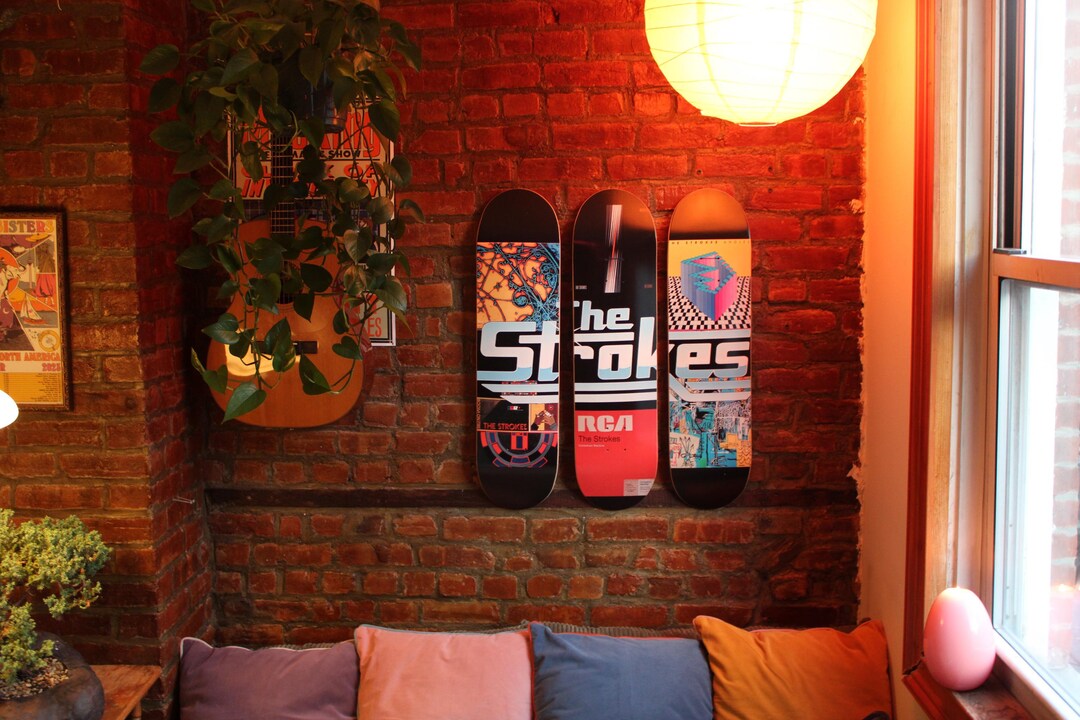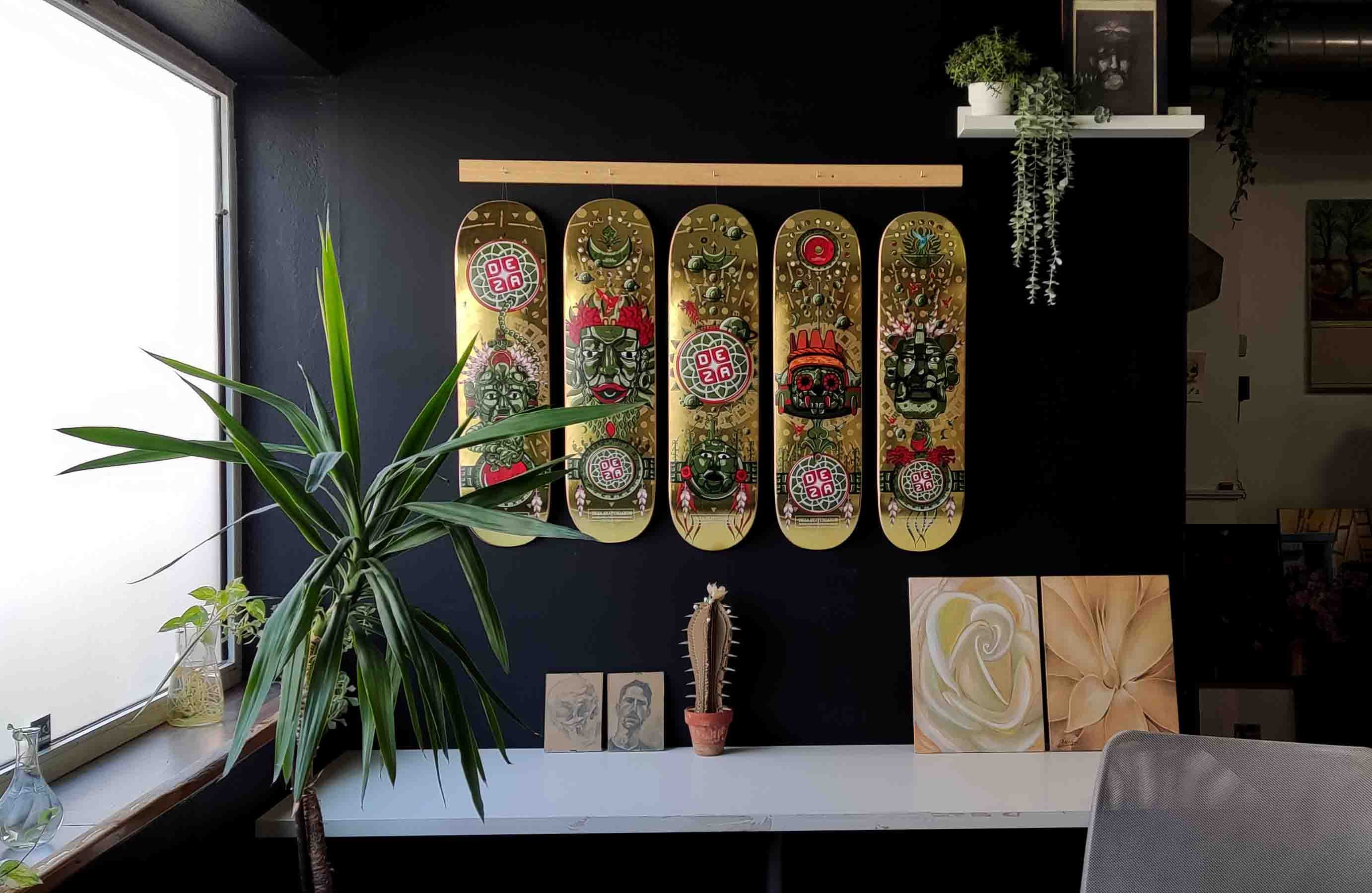Walking through my Berlin apartment last Tuesday, I realized something weird: my skateboard art collection matches my music taste almost perfectly. The Bouguereau Amor & Psyche deck duo hanging above my turntable mirrors the classical records I play most often—baroque, ornate, emotionally complex. My minimalist Japanese-inspired pieces sit near my ambient electronic vinyl. It wasn't intentional, but actually... maybe it was?
This got me thinking about something The Guardian explored in their research on music and wellbeing: music isn't separate from us—it "lives inside each of us who listen." And if that's true, doesn't the visual art we choose reflect those same internal rhythms?
The Synesthesia Effect: When Visual Becomes Audio
You know that feeling when you look at a painting and swear you can almost hear it? That's not just poetic language—there's actual neuroscience behind it. Some artists literally experience synesthesia, seeing colors when they hear music. But even for those of us without that neurological wiring, our brains create cross-sensory connections.
When I look at our Girl with a Pearl Earring deck duo, I hear quiet, contemplative chamber music. The soft blues and golds translate to gentle strings in my mind. It's like visual ASMR.
 Skateboard art creating visual harmony inspired by musical themes
Skateboard art creating visual harmony inspired by musical themes
Forbes research on musical spaces notes that "music lives as fluid architecture," and I think skateboard art works the same way. Both create atmosphere without demanding attention. They exist in your peripheral awareness, shaping mood and energy.
Matching Visual Art to Musical Genres
After four years curating classical art skateboards in Berlin, I've noticed patterns in how people pair art with their musical preferences. It's fascinating.
Classical Music Lovers gravitate toward Renaissance and Baroque pieces. They want compositional complexity—multiple visual elements interacting like different instruments in an orchestra. Our classical art collection speaks to them because each piece has that layered richness.
Jazz Enthusiasts prefer more abstract interpretations. They like seeing classical art recontextualized on skateboards because it mirrors jazz's approach—taking familiar themes and improvising new meanings.
Electronic/Ambient Fans lean toward minimalist pieces or single-figure compositions. Clean lines. Lots of negative space. Visual silence that complements audio minimalism.
Rock/Alternative Listeners often choose dramatic, high-contrast pieces. Think Caravaggio's intense light-dark interplay. Visual energy that matches sonic intensity.
The Rhythm of Wall Arrangements
Here's something I learned from Red Bull Ukraine event planning: spatial arrangement creates visual rhythm, just like tempo creates musical rhythm.
 Strategic skateboard art placement creating visual tempo in interior design
Strategic skateboard art placement creating visual tempo in interior design
Allegro (Fast) Arrangements: Multiple decks clustered together, different sizes, varied spacing. Creates visual movement and energy. Perfect for spaces where you listen to upbeat music—kitchens, workout areas, social spaces.
Andante (Moderate) Arrangements: Evenly spaced pieces at consistent intervals. Visual steadiness. Works beautifully in bedrooms or listening rooms where you want calm focus.
Largo (Slow) Arrangements: Single statement pieces or wide-spaced pairs. Lots of breathing room. Ideal for meditation spaces or areas dedicated to ambient/classical listening.
The Forbes article mentions that "location of the space, lighting should be taken into consideration" for music rooms, and the same applies to skateboard art placement. How light hits your pieces throughout the day creates different "performances"—morning light brings out warm tones, evening light emphasizes shadows and depth.
Color Theory Meets Music Theory
Working with Ukrainian streetwear brands taught me how color creates emotional resonance. The same principles apply when pairing skateboard art with music spaces.
Warm Colors (Reds, Oranges, Golds): These vibrate at visual frequencies that complement brass instruments, string sections, passionate vocals. They create warmth and intimacy—perfect for jazz lounges or classical listening spaces.
Cool Colors (Blues, Greens, Purples): Lower visual frequencies that pair beautifully with woodwinds, synthesizers, ambient soundscapes. They create contemplative atmospheres.
High Contrast (Blacks and Whites): Sharp visual dynamics matching percussive elements, electronic beats, dramatic classical movements.
The Collector's Playlist Approach
Think about building your skateboard art collection like curating a playlist. You wouldn't make a playlist with 47 songs in the same tempo and key, right? (Well, maybe for running, but that's different.)
Your art collection should have:
Opening Tracks: Attention-grabbing pieces that set the tone when someone enters your space. Statement works that announce your aesthetic immediately.
Deep Cuts: More subtle pieces that reveal themselves over time. The visual equivalent of album tracks you skip at first, then realize are genius three months later.
Interludes: Smaller pieces or transitional works that connect larger themes. Visual palate cleansers.
Crescendos: Your most dramatic, emotionally powerful pieces. Save these for focal points where they can dominate attention.
Acoustic Spaces and Visual Resonance
The Guardian article mentions how music "lives inside each of us," and I think our homes become external manifestations of that internal music. Your art choices literally visualize your soundtrack.
When someone visits my apartment and sees classical Renaissance skateboards near my turntable, they immediately understand something about my relationship with both art forms. It's communication without words—or music—but the message comes through clearly.
Interior designer Debbe Daley (quoted in Forbes) created a music room where "climate control was needed to ensure the air is consistently regulated for the guitars." I think about skateboard art similarly. The environment you create around these pieces affects how they're experienced. Are they competing with visual noise, or do they have space to breathe?
The Home Gallery Experience
Here's what I love about skateboard art as visual soundtracks: they democratize the gallery experience. You don't need to visit a museum to experience classical masterpieces. You don't need a concert hall to feel moved by beauty.
Your living room becomes a gallery. Your bedroom becomes a listening room. The art doesn't just hang there—it performs, creating atmosphere and emotion.
As The Guardian research points out, "engaging with arts improves quality of life, increases productivity and creates financial dividend." But more than that, it creates daily moments of beauty that compound over time.
Practical Pairing Strategies
For Your Music Listening Space: Choose art that complements your primary listening genre but offers contrast. If you mostly listen to aggressive music, softer visual elements provide balance. If you prefer ambient sounds, bolder art creates interesting tension.
For Social Spaces: Select pieces that spark conversation. Art with storytelling elements—like our classical reproductions—gives guests entry points into discussions about culture, history, technique.
For Private Spaces: Go with what genuinely moves you emotionally, regardless of "rules." Your bedroom or personal study should reflect your unfiltered aesthetic.
For Workspaces: Consider how art affects focus. Some people need visual calm to concentrate; others thrive with stimulating surroundings. Honor your process.
The Emotional Frequency Match
Music therapist Renate Rohlfing (quoted in Forbes) explains that music "can resonate with our emotional state." Visual art works identically. The right piece at the right moment can amplify or soothe your mood.
I've noticed my emotional response to our Birth of Venus piece changes depending on what I'm listening to. With Debussy playing, I see softness and grace. With Stravinsky, I notice dynamic tension in the composition. The art remains constant, but the soundtrack changes how I perceive it.
Building Your Visual Soundtrack
Start by identifying your top five most-played albums or artists. What visual qualities do they share? Complexity or simplicity? Warmth or coolness? Energy or calm?
Then look for skateboard art that echoes those qualities. You're not looking for literal musical instruments in the artwork—you're looking for pieces that vibrate at similar emotional frequencies.
Trust your instincts. If you feel drawn to a particular piece while listening to your favorite music, that's your brain making cross-sensory connections. Honor that.
The best part about using skateboard art as visual soundtracks? You can rearrange them. Unlike painted walls or permanent installations, you can remix your visual playlist as your musical tastes evolve.
For more on building cohesive art collections, check out our guide to skateboard art authenticity and our exploration of skateboard art communities.
About the Author
Stanislav Arnautov is the founder of DeckArts and a creative director originally from Ukraine, now based in Berlin. With extensive experience in branding, merchandise design, and vector graphics, Stanislav has worked with Ukrainian streetwear brands and organized art events for Red Bull Ukraine. His unique expertise combines classical art knowledge with modern design sensibilities, creating museum-quality skateboard art that bridges Renaissance masterpieces with contemporary culture. Follow him on Instagram, visit his personal website stasarnautov.com, or check out DeckArts on Instagram and explore the curated collection at DeckArts.com.

